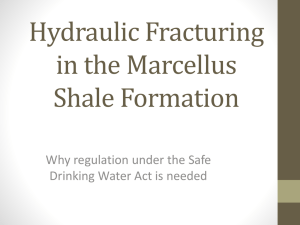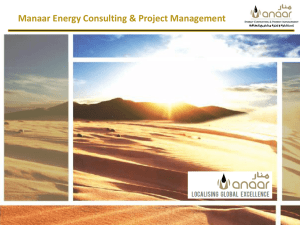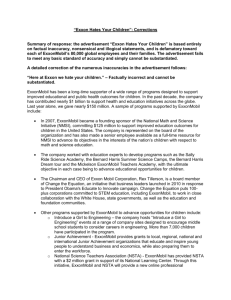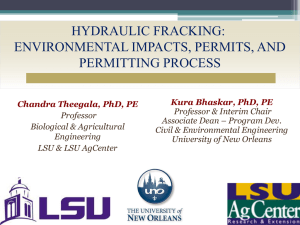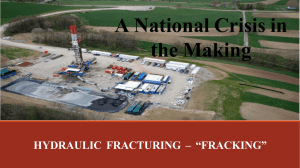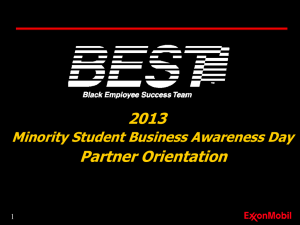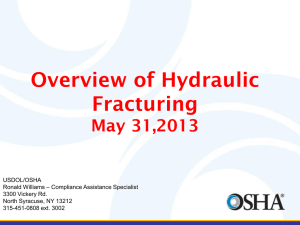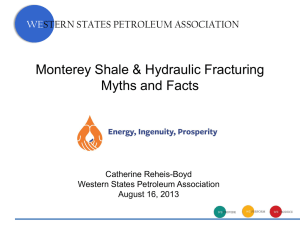ExxonMobil*s communicative defense of hydraulic fracturing
advertisement
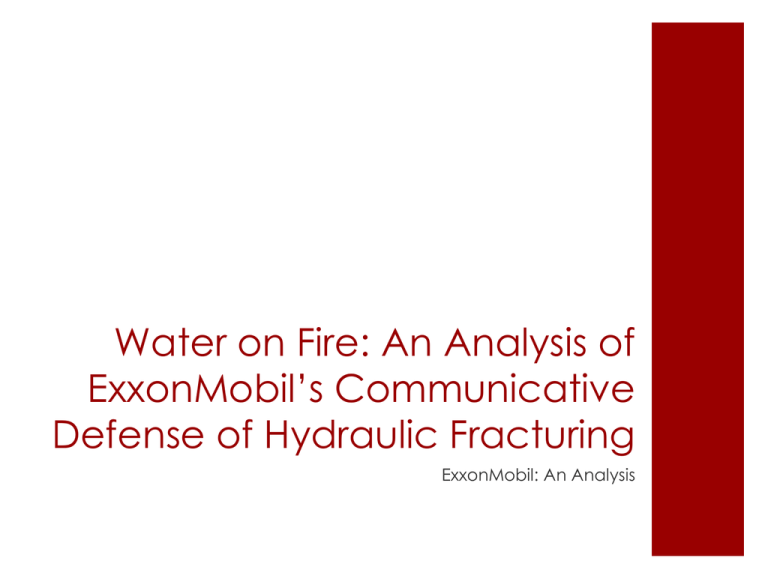
Water on Fire: An Analysis of ExxonMobil’s Communicative Defense of Hydraulic Fracturing ExxonMobil: An Analysis ExxonMobil Company History • Created on November 30, 1999 when the companies Exxon and Mobil merged • As of 2009, ExxonMobil produces nearly 50 percent more natural gas than its closest competitor. • ExxonMobil remains “America’s most valuable company” with a market capitalization of $350.1 billion. • ExxonMobil’s revenue from 2010: $383.2 billion compared to 2009 revenue: $310.6 billion paints a clear picture of increasing strength • Business model commits to valuing safety, operational excellence and risk management. What is hydraulic fracturing? • Definition: An energy extraction process that involves drilling deep into the Earth’s surface using a mixture of chemicals and water to capture natural gas • Used in small scales since 1940s • Recently large energy companies, including ExxonMobil, have begun incorporating the practice Source: Nick Mann, “Hydraulic Fracturing: Making the Headlines in 2011,” Of Peace and Politics,” March 8, 2011. Accessed on December 26, 2011 from http://ofpeaceandpolitics.wordpress.com/2011/03/08/hydraulic-fracturing-makingthe-headlines-in-2011/ Why a campaign? • Negative media coverage forces ExxonMobil to tell its side of the story---that it can perform hydraulic fracturing safely, without negative consequences for health or the environment. • Thousands of reports exist claiming hydraulic fracturing causes neurological impairments and nausea. • In rare cases, some report the process has leached toxins that cause cancer and miscarriages. • Despite an ongoing investigation, the EPA has yet to confirm a link between hydraulic fracturing and groundwater contamination Why is ExxonMobil taking the risk? • Trying to appease key stakeholders who desire a safe, clean energy alternative • Attempt to remain ahead of competition “When it comes to hydraulic fracturing, ExxonMobil doesn’t have a choice. As the biggest U.S. energy company, it has to join with other companies in the oil and gas business in educating the public about what hydraulic fracturing is, why it’s essential to U.S. energy production, and why it’s not a threat to the environment.” -Robert Bryce, Senior Fellow at the Manhattan Institute Chronology of ExxonMobil’s communication regarding hydraulic fracturing January 20, 2010. At a congressional hearing regarding the merger of ExxonMobil with XTO Energy, ExxonMobil CEO Rex Tillerson told members of the House Energy and Commerce subcommittee, “There have been over a million wells hydraulically fractured in the history of the industry, and there is not one, not one, reported case of a freshwater aquifer having ever been contaminated from hydraulic fracturing. Not one.” January 27, 2011. In ExxonMobil’s annual “Energy Outlook” report, hydraulic fracturing is described as involving, “injecting a solution that is primarily water and sand—mixed with a small amount of chemicals often found in swimming pools, dish detergents, and other common uses—to open up cracks in water formations that allow the natural gas to migrate to the well.” Chronology of ExxonMobil’s communication regarding hydraulic fracturing May 2011. ExxonMobil begins testing the advertising waters—running full page spreads in both the New York Times and the Washington Post claiming hydraulic fracturing is both safe and essential to American energy security and job growth despite critics’ claims that the ads are misrepresentative. May 19, 2011. ExxonMobil uploads the first of its soon-to-be national television advertisements titled, “ExxonMobil: Unlocking a Century’s Supply of Natural Gas” to its official YouTube account. The TV ad claims ExxonMobil now has the technology to safely “unlock this clean burning natural gas that will provide us with fuel for 100 years--providing energy security and economic growth all across this country.” This first advertisement does not mention hydraulic fracturing by name or the controversies some associate with it. Chronology of ExxonMobil’s communication regarding hydraulic fracturing May 25, 2011. At the 2011 ExxonMobil Annual Shareholder’s meeting, “a resolution calling for the company’s board of directors to prepare a report on known and potential impacts of ExxonMobil’s fracking operations” is defeated after receiving only 28.2 percent of votes from shareholders. May 25, 2011. Tillerson tells reporters “overzealous regulation of hydraulic fracturing is impeding development of gas fields vital to America’s economic success.” Tillerson announces ExxonMobil is planning an advertising campaign to defend natural gas drilling techniques. The campaign, he says, is needed in part because, "We have some problems in getting out the message with some of you folks [media]. So we have to go out and buy some of the space in which to present the industry’s viewpoint.” Tillerson said the campaign is to include traditional advertising combined with town hall meetings. Chronology of ExxonMobil’s communication regarding hydraulic fracturing June 30, 2011. ExxonMobil announces the launch of its natural gas information website: www.aboutnaturalgas.com. The announcement is made on ExxonMobil’s ‘Perspectives’ blog and explains, “The new website houses facts, figures and graphics that give context to the growth of natural gas resources in the United States, as well as the hydraulic fracturing technology that helped unlock these supplies.” August 10, 2011. The second national television spot titled, "Natural Gas: An Amazing Resource, a Responsible Way to Produce it” is uploaded to YouTube. In this advertisement, Oswald returns to narrate. This time, ExxonMobil makes an acknowledgement that there is much discussion and debate surrounding natural gas drilling. But no specifics are included in the ad about the possible dangers of hydraulic fracturing. Chronology of ExxonMobil’s communication regarding hydraulic fracturing August 25, 2011. Following a report by the Department of Energy calling for improvements in shale gas production by the gas and oil industry, ExxonMobil reminded stakeholders on its ‘Perspectives’ blog that it had already been complying with one of the report’s recommendations: voluntarily disclosing the contents of fracking fluids on the website FracFocus.org. Repercussions Media • Media coverage of the process is decidedly negative and few news reports mention scientific research of the practice. • The amount of media coverage is extensive. As of November 2009, 2,289 articles had been written about hydraulic fracturing which represented a 265 percent increase in coverage compared to the previous three years. • Media coverage was so much of an issue, in fact, that members of the environmental group As You Sow introduced a resolution at ExxonMobil’s annual shareholder meeting asking the company to, "come clean on the serious environmental, public health and financial risks of hydraulic fracturing.” Repercussions Stakeholder Response • Prior to the announcement of ExxonMobil’s advertising campaign on May 25, 2011, stock prices closed at $81.96. The day following the announcement of the campaign, stock prices rallied, closing at $82.39. • However, once the national advertising campaign started in the fall of 2011, stocks did see a drop to $73.49. Yet, this drop cannot be concretely linked to the start of the campaign. • Senior strategist Michael Passoff of the As You Sow Foundation (an environmental group that holds ExxonMobil stock) said the announcement of the campaign did not put the group’s concerns at ease, “It’s going to take more than an ad campaign. Everyone would be better off if they spent that money in the fields, doing things like reducing toxins in fracking fluids and safeguarding water quality.” Application of the Page Principles 1. Tell the truth ExxonMobil should be applauded for voluntarily disclosing chemicals the company claims to use in the process of hydraulic fracturing. Furthermore, initiating a campaign to inform the public of how the process works is an important start of the critical information sharing process. However, comments from senior leadership that claim hydraulic fracturing has never caused contamination should be avoided as without complete confirmation from the EPA’s report, comments like that could quickly backfire on the company. Application of the Page Principles 2. Prove it with action ExxonMobil has provided concerned stakeholders with many forums to further understand how hydraulic fracturing works. The website www.aboutnaturalgas.com was created to aid understanding of the process and includes video demonstrations of how hydraulic fracturing works and how ExxonMobil claims to do it safely. All in all, ExxonMobil has done a good job in showing its stakeholders how they fracture, which is a step up from simply saying the company does the job safely. However, further action could be taken to reinforce ExxonMobil’s claim of safe practices. For example, ExxonMobil could have capitalized on the call for a report on its use of hydraulic fracturing at the 2011 annual shareholders meeting. Application of the Page Principles 3. Listen to the customer By implementing the information-based campaign, ExxonMobil took a needed step. They listened and acknowledged the need of customers to learn more. However, by ignoring calls from stakeholders to become more transparent about the company’s use of hydraulic fracturing, ExxonMobil failed to acknowledge another important desire of stakeholders---transparency. 4. Manage for tomorrow Both ExxonMobil’s leadership and official communication regarding hydraulic fracturing have not sufficiently prepared for results that contradict its message. CEO Rex Tillerson’s previous comments saying there is no link to hydraulic fracturing and water contamination did not sufficiently prepare the company for a situation in which a link was found. In fact, Tillerson’s comments could backfire on ExxonMobil if such a link is confirmed in the EPA’s final report. Application of the Page Principles 5. Conduct public relations as if the whole company depends on it While certain elements of ExxonMobil’s information-based campaign have served to engage key stakeholders and foster relationships by reaching out with relevant information, other elements of ExxonMobil’s campaign could be improved. The website www.aboutnaturalgas.com was created to spread information about natural gas, why it’s important and how it works. Although information spreading is vital for the campaign, the website offers no forum for concerned stakeholders to ask questions. Instead, if anyone wishes to ask questions about the process they have to turn to ExxonMobil’s official blog ‘Perspectives,’ where comments are seldom responded to in a timely manner. By increasing two-way communication, ExxonMobil could capitalize on an opportunity to truly foster relationships and enhance credibility as well as the public’s trust of ExxonMobil’s use of hydraulic fracturing. Application of the Page Principles 6. A company’s true character is expressed through its people The fact that ExxonMobil employees are bright, hardworking and driven toward excellence is undeniable. One clear way of understanding the type of people who make up a company is by looking at a company’s core values from which they operate under and and hire from. If one word were to define ExxonMobil’s self-described way of business it would be integrity---integrity of people and integrity of risk management. Yet, it is important to remember the role senior leadership plays in the character of the company. Comments perceived as disparaging or nonsympathetic to concerns can do just as much to harm the reputation and character of a company as the actions of individual employees. Application of the Page Principles 7. Remain calm, patient and good-humored ExxonMobil’s television advertisements did a good job of remaining calm and patient, acknowledging a debate surrounding the issue of hydraulic fracturing but at the same time assuring the public of ExxonMobil’s prowess regarding the extraction process. With the exception of CEO Rex Tillerson’s comments at the 2011 annual shareholder meeting, ExxonMobil appears to be going through the process of the advertising campaign in a calm, patient manner. There seems to be a focus on the long haul---realizing that a long discussion is to be held by the public, government and industry before any final referendum on hydraulic fracturing is had. It is important that ExxonMobil remain focused on the long-term future, maintain patience and calm in the face of competing claims about the process and be prepared to acknowledge and work with results from the EPA’s ongoing investigation in order to truly show the public the company’s commitment not only to energy and financial excellence but to human excellence as well. Discussion Questions 1. Why are stakeholders important for a company’s overall success and longevity? 2. Why is it important that a company has the ability to defend its views while at the same time respecting concerns? How does that respect aid in relationship building with key stakeholders? 3. How does transparency aid in strengthening and maintaining a company’s relationship with key stakeholders? 4. Is ExxonMobil focused on all talk and no action? Or do they need to do a better job of highlighting the action that is already being taken by the company to make hydraulic fracturing safe? Discussion Questions 5. Did ExxonMobil lose credibility with its decision to not vote for the report requested by concerned shareholders? Or did it display a position of strength and decisiveness in its actions? Which is better in this case? 6. As a public relations professional, would you recommend ExxonMobil’s CEO support the report? How would you recommend he/she justify not voting for it? 7. Is it ethical for ExxonMobil to compare chemicals used in hydraulic fracturing to everyday chemicals used in the household without disclosing the impacts of greater amounts of the chemicals? 8. What are the most important steps you would include in your strategic management plan for ExxonMobil in its handling of the hydraulic fracturing issue? ExxonMobil’s Challenge Regardless of how the debate ends, the consumer’s search for understanding of the process of hydraulic fracturing should never be belittled by ExxonMobil. If dangers do exist, the challenge for ExxonMobil is to fully and openly embrace them with no communicative sugarcoating. After all, it’s not only a company’s reputation and stock options at stake---it could be the wellbeing of its consumers as well.
